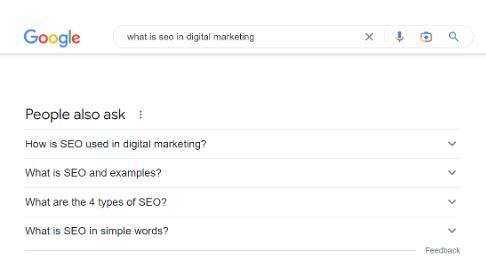Search engines evolve as consumer problems change. This correlation explains the frequent Google updates and why digital marketers should be on their A-game to deploy the right marketing strategies.
In this article, explore why optimising for People Also Ask (PAA) is important in any SEO (Search Engine Optimisation) strategy and some best practices to ensure that your website wins this enticing spot – which is good for reeling in organic traffic and potentially driving conversions.
What is “People Also Ask”?
PAA is a section in the search engine results pages that display additional information on what users are searching for. It’s exclusive to Google and provides users with questions related to their search queries and their respective answers.
The questions in the PAA box consist of detailed information in the form of featured snippets (questions and answers) related to a particular query. These questions and answers are what users would potentially search for online and is linked to a source (usually a website).
In summary, should companies optimise for PAA? – Absolutely!
Understanding Google’s People Also Ask Box
Before explaining the best practices to follow when optimising your content and getting your website featured in the PAA box, we will look at an illustration to help you understand this rich snippet function in the results pages.
A user types the following query in a search engine: “what is SEO in digital marketing”. Then on the results page, the user is served with a box (as pictured below) with other related questions that they might find useful. Having the users’ queries answered in one of these snippets further bolsters the whole idea of user experience and helpful content – which are both vital for ranking.

As a marketer, you want your business to appear in one or more of these snippets and that can only be attained if your content is correctly optimised with the right keywords or semantics. This is where a well thought out SEO content strategy comes in.
How to Optimise for People Also Ask
1 – Identify keywords and user pain points
Before SEO content creation, keyword research is usually carried out. Optimising for PAA is not just looking at keywords with high search volumes (as you would do for content creation), but it’s also knowing who your customers are and researching what they might be searching for.
In the research, you must identify the “pain points” of users, what queries are popular and proceed to provide a succinct answer to these questions. Tackling the pain points by giving users what they require in a Q&A format will potentially lead to a higher conversion rate.
2 – Stay away from technical jargon
Another point to consider when optimising for PAA is to avoid technical jargon. The content must be clear and concise placing emphasis on the 5Ws (what, when, who, where & why). By using this simple Q&A format, search engines would be more inclined to show your content on the results pages. Furthermore, the 5Ws are highly favoured in search as people tend to use them more.
3 – Don’t be too salesy
When optimising for PAA, avoid the salesy approach, where content is solely written to drive sales. It’s advisable to take the user through a journey with your content rather than telling them to “buy now” or “click here”. You want to answer a specific question, for example, a “how to learn Spanish” query should immediately provide the user with a succinct answer, as opposed to trying to convert the user immediately or even adding more rhetoric to the mix. This will not only confuse the user, but the user is also going to bounce off your page and engage with other relevant content.
4 – Carry out PAA competitor research
This is simultaneous to competitor gap analysis where you analyse the search engine results pages for websites that are ranking in the PAA box and review their content to improve it, so your site pages can take the winning spot!
Finally, considering the PAA research approach in your content strategy not only helps to improve rankings and drive traffic to your site, but it also simplifies the user experience by displaying relevant, useful, and qualitative information to your target audience.
Want to revamp your SEO strategy? Get in touch with our team of SEO experts to get the ball rolling.
